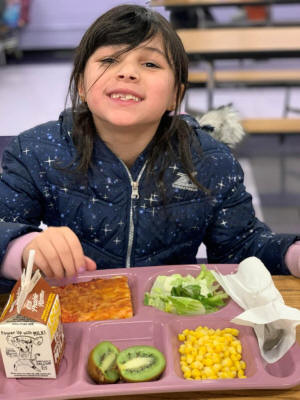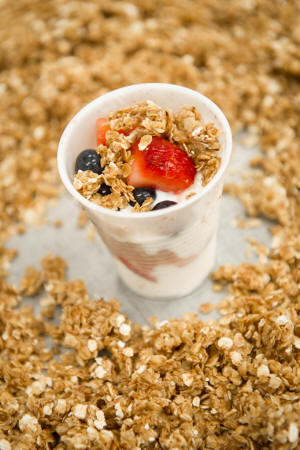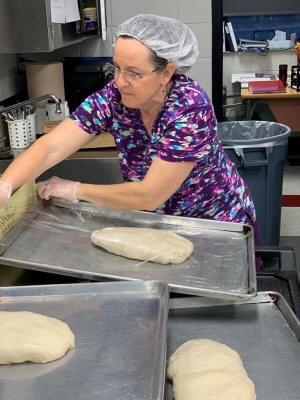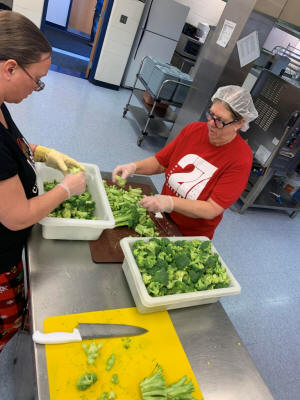|
 Thursday, the cooks run each slice of chicken
through a three-step breading process: first, a seasoned flour mixed
with onion powder, garlic powder, paprika, salt and pepper; second,
an egg wash; and finally, the breadcrumbs. The finished chicken
strips are placed on sheet pans, ready to be baked in the oven until
golden brown, and devoured by students in need of a nutritious meal
to soak up all the learning for the day. Thursday, the cooks run each slice of chicken
through a three-step breading process: first, a seasoned flour mixed
with onion powder, garlic powder, paprika, salt and pepper; second,
an egg wash; and finally, the breadcrumbs. The finished chicken
strips are placed on sheet pans, ready to be baked in the oven until
golden brown, and devoured by students in need of a nutritious meal
to soak up all the learning for the day.
As a Coordinated Approach to Child Health (CATCH) district, creating
a healthy school environment is a priority for LESD 27.

Lincoln Elementary School District launched a farm to
school cafeteria program, 'Lincoln 27 and Beyond,' at the start of
the 2019-2020 school year in collaboration with the Abraham Lincoln
Memorial Hospital Community Health Collaborative and through grant
funding provided by Abraham Lincoln Memorial Hospital Foundation.

The initiative brought Beyond Green Sustainable Food Partners to
lead the kitchen transformation.


In addition to eating delicious, made-from-scratch
breakfasts and lunches, students tour the cafeteria to learn about
cooking preparations, meet farmers, and learn about food and
agriculture in the classroom.




Meanwhile, school cooks receive culinary and production skills
training to operate more like a 5-star restaurant for kids.
The program is based on a simple concept articulated by a third
grade student of the district who when asked, "What would you change
to convince your friends who don’t eat school lunch to eat school
lunch?" said, “Like Lincoln 27 and Beyond, ask the kids what they
want and then put it on the menu.”
Through taste tests, surveys, and lunchroom and classroom
discussions, students provide input on what they want to eat at
school. The student driven menu highlights sloppy Joes, macaroni and
cheese, and chicken and noodles, with sprinklings of new foods such
as kale and turnip chips, garbanzo beans, and beets.
The principle idea is to scratch-cook healthy, kid-friendly dishes
that are free from preservatives and chemicals used in processed
foods while introducing their palates to new flavors of nutrient
dense foods. Even second graders recognize the long term benefits of
starting healthy eating habits now, saying, “We can remember when we
are older and get out of school, we can still eat healthy and be
strong.” Healthy adults emerge from healthy
children – that’s the premise of how 'Lincoln 27 and Beyond' came to
be.
Abraham Lincoln Memorial Hospital Community Health Collaborative
brought the CATCH program to the district in 2016 as part of a
community mission to address high rates of obesity in the county.
CATCH is a national program that has historically launched kids and
communities toward healthier lifestyles.
[to top of second column] |
 LESD 27 was a great fit for the program. In
addition to reaching the majority of Logan County children, the
district food service director and cafeteria staff were willing to
take on the challenge to provide the best quality foods possible to
the students. After all, it’s not an afternoon picnic to transform a
community’s relationship with food or completely upend how a kitchen
operates or run a program that crosses all departments within the
school, and yet, 'Lincoln 27 and Beyond' would do all three.

Chef Greg Christian, Founder and CEO of Beyond Green
Sustainable Food Partners has worked with several dozen schools
across the North American continent and has never seen such a deep
level of commitment from all departments of a school and from the
entire community. “Everyone from the cooks and custodial staff to
teachers and aides to administrative support staff are dedicated
whole-heartedly for the kids to win at school and in life. I have
not met a single person who is too busy to support the program or
who doesn’t see the value. It’s been all hands on deck since day
one, which is critical to turn this ship around to where we are
taking care of all the people, the community, and the environment.
And it all starts with strong leadership from (District 27
Superintendent) Kent Froebe.”
The transformation to a scratch cooking program is the direct result
of Crawley’s hard work and her team of 16 staff. Cooking from
scratch requires new systems and ways of working in the kitchen and
they have all risen to the challenge.


For example, to find the time to chop, mix, and
sauté, the cooks have to plan ahead and collaborate. They now have
12 steps for every one step they used to do, which means they work
harder in addition to smarter.

One cook expressed the purpose for which they all
work, “[I feel] overwhelmed at times but I feel it’s good for the
children in being able to provide good quality food.”
Along with adopting new kitchen practices to cook from scratch, the
kitchen staff weigh food daily to reduce waste. The savings from
reduced waste allows the school to purchase higher quality
ingredients from local farmers.
LESD spent 20% of their budget on local food in the program’s first
three-and-a-half months. In the course of a school year 20% of the
budget will result in approximately $90,000 going directly to local
farmers. The goal is 30%, which will be achieved next year with more
time for farmers to prepare for the new demand, and with the more
skilled to cooks with local food the entire year.
When LESD reaches their local food goal of 30%, $135,000 will stay
in the community annually.
Taking these numbers statewide, if other schools would follow suit
with this leading program in Lincoln, the state would generate $150
million by spending 20% on local food purchases and $225 million by
spending 30% on local food purchases.
The program measures criteria for nine goals. With more than two
dozen data points the program staff are able to monitor real results
in real time and make the needed adjustments.
LESD reached 60% scratch-cooked meals in the first semester and will
be at 100% by the end of the school year. However, more than scratch
cooking simply happening, data informs whether students are eating
the food and liking the food; whether attitudes and behaviors about
food are changing not only with students but parents as well;
whether a correlation exists between healthy eating and absenteeism;
and more. “We have third-party evaluation on this program for a
total of three years,” says Lincoln Elementary School District
Superintendent Kent Froebe.
“We are committed to playing our part in supporting Logan County to
become the healthiest county in the country. Lincoln 27 and Beyond
is a long-game with far-reaching benefits for the whole community.”
|
Read all the articles in our
new
2020 Education Magazine
Title
CLICK ON TITLES TO GO TO PAGES |
Page |
|
Introduction |
4 |
|
Teaching students to cope with stress |
5 |
|
First of its kind Illinois school meal program
at Lincoln Elementary School District # 27
achieves high marks in the opening semester |
8 |
|
West Lincoln-Broadwell students actualize
studies in comet data mission |
14 |
|
Students gain mental acuity at Hart-Em Chess
Club |
19 |
|
Exciting things ahead for the future of Mount
Pulaski CUSD # 23 |
23 |
|
School Report: Mount Pulaski Community
Unit District #23 |
30 |
|
Logan County School Information |
31 |
|
|